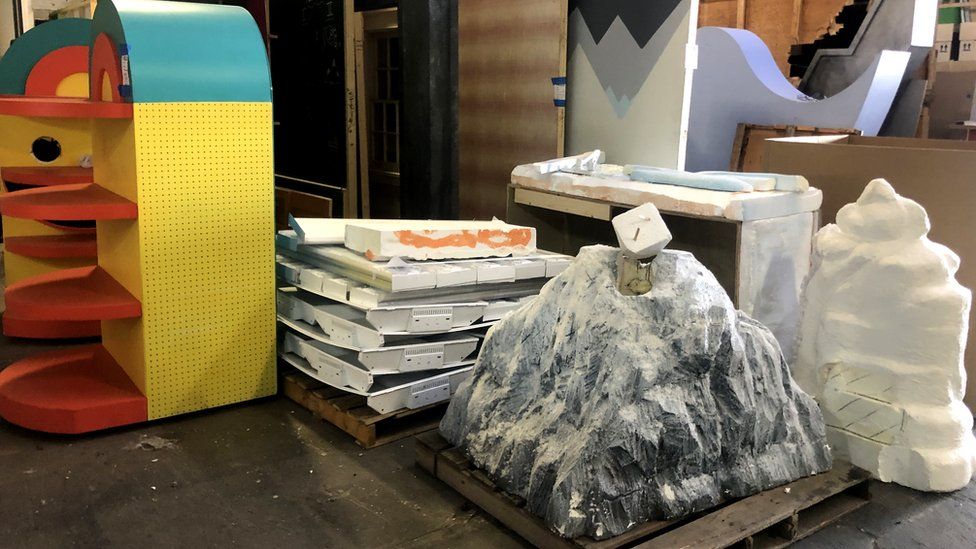ARTICLE AD BOX
By Christine Ro
Technology of Business reporter
 Image source, Christine Ro
Image source, Christine Ro
What have you been in? These items from film and TV await new owners
The Materials Oasis in Los Angeles is a warehouse that looks like a sorting area for the world's biggest charity shop. It's full of vases, sofas, artwork, artificial plants, plastic bins of sand, wall sections, and even bags of packing paper.
This motley collection of items isn't for sale. All the goods here have been discarded from the film and TV industry, and are being offered free of charge to other filming productions, non-profits, schools, or others who can make use of them.
EcoSet, the company that runs the Materials Oasis, also provides set services to help productions reach the zero waste standard of 90% of waste diverted from landfill or combustion.
Reese Medefesser, the reuse co-ordinator for EcoSet, is continually surprised by what people will take, and for what purpose. Eventually every single item will receive a second life - even if his team needs, for instance, to dismantle a massive scenic wall before people can arrive to cart away the pieces.
Often shoppers for film and TV will start here, to spark ideas before production. And following production, working with EcoSet can be a cost-effective alternative to paying disposal fees - as well as allowing a production company to tout its environmental actions.
A blockbuster film like Jurassic World: Dominion churns through an enormous number of materials. So the production team looked for creative ways to ensure that many of those materials could have a second life.
Image source, Getty Images
Image caption,Jurassic World: Dominion, starring Chris Pratt, melted down the moulds used to create the dinosaurs
For instance, the animatronic dinosaurs were created using silicon and fibreglass moulds. The scenery salvage company Green Clover melted down those moulds for future use.
Even the stunt wire, which can't be used again in its current form for safety reasons, was pulled apart to create new wire.
This is the second in a two-part series about making the TV and film industries more environmentally-friendly. You can read the first part here.
A number of film studios have announced sustainability goals, such as carbon neutrality by 2035. These have varying levels of ambition, but they generally incorporate some level of waste reduction, from donating or composting leftover food to replacing single-use plastic water bottles, to minimising the amount of paper used on set.
This is relatively low-hanging fruit. Louise Smith, a sustainability consultant with Neptune Environmental Solutions, explains why so many production teams have embraced waste reduction: "Waste and plastics is something that every single crew member can see physically, every single day. And so it's something that's ever present in people's minds."
Even more production items could be reused with tweaks to protect intellectual property. For instance, props where the design has been copyrighted could potentially have their identifying features removed.
And on a larger scale, retrofitting existing spaces can be less wasteful than building stages from scratch.
Image source, Getty Images
Image caption,Producers are encouraged to recycle sets
Waste is one of many aspects a filming production needs to log in order to qualify for sustainable production certification from the environmental organisation albert. You may have seen this logo in the end credits of a TV programme.
To prove prop reuse, for instance, albert may need to see a production's rental invoices for second-hand purchases.
These kinds of certifications remain voluntary. In the absence of governmental regulation to ensure greener practices, the film and TV industry has created a number of agencies to encourage more sustainable production, on an optional basis.
Another group with an interest in the sustainability of the industry has formed with the intention of launching at the COP 27 climate conference in November. Their initiative, whose working title is the Entertainment Net-Zero Accord (ENZA), aims to set out guidelines for the TV and film industry that align with the Paris Agreement.
After a production decides, often based on corporate commitments, to implement waste reduction policies, the person charged with doing so on the ground might be called an eco PA, a sustainability co-ordinator, a green runner, or another relatively new job title. But it can be a challenge for them to command respect within a large team.
"These are very new positions within a very hierarchical sector and industry that has deeply embedded roles and relationships," says Hunter Vaughan, an environmental media scholar at the University of Cambridge. "So they work at a massive disadvantage."
Dr Vaughan, who has referred to the hidden environmental impact of screen media as Hollywood's Dirtiest Secret, is cautious about the sustainability claims of the industry. "The screen arts industry is very well versed with… constructing public image," he says.
One example is the proliferation of digital processes, which has been held up as a way of reducing physical waste. For instance, previsualisation allows for shots to be tested virtually in advance, while 3D capture of set components may mean that extra props don't need to be trucked around.
Image source, Getty Images
Image caption,Digitally generated scenes save on materials
Especially during the Covid-19 pandemic, some crews embraced digital call sheets, scripts and other documents in place of the abundant paper that can litter film shoots.
While some of these practices are clearly helpful for reducing waste, digital postproduction may simply duplicate physical processes. "These films that claim to be largely digital still require a lot of analogue work," Dr Vaughan cautions.
The environmental impact of the film and TV industry is, like the industry itself, large and multi-faceted. Reese Medefesser recognises that "little lonely old EcoSet is not going to be able to change that".
But he's encouraged by the generational changes he has witnessed, with crews moving away from the old ideas of building items for a single use and then throwing them away.
His colleague Jodi Waxman, EcoSet's product and donations co-ordinator, gestures to the electrical goods around her. "Twenty years ago, that fridge would have ended up in a landfill," she says.
It is incremental, and it can't be the endpoint of sustainability efforts in media arts. But organisations working in this space are striving to make their industry less waste spewing, one fridge at a time.

 2 years ago
37
2 years ago
37








 English (US) ·
English (US) ·